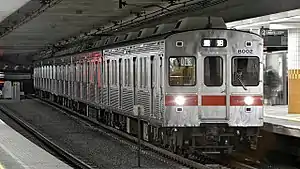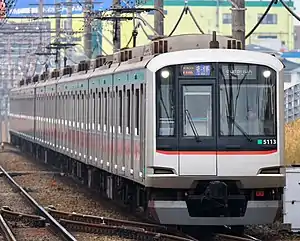Tokyu 8000 series
The Tokyu 8000 series (東急8000系, Tōkyū 8000-kei) is a commuter electric multiple unit (EMU) train type operated by the private railway operator Tokyu Corporation in Japan from 1969 until 2008. A number of 8000 series trains are still operated by Izukyū Corporation in Japan and on the KRL Commuterline network in Indonesia.
| Tokyu 8000 series | |
|---|---|
 8000 series train at Ōokayama Station in February 2008 | |
| In service | 1969–present |
| Manufacturer | Tokyu Car |
| Constructed | 1969–1985 |
| Entered service | 1969–2008 (Tokyu Corporation) 2004–present (Izukyū Corporation) 2005–present (Kereta Commuter Indonesia) |
| Scrapped | 2004– |
| Number built | 677 vehicles |
| Number in service | 69 vehicles |
| Number preserved | 1 vehicle |
| Number scrapped | 607 vehicles |
| Formation | 5/8 cars per trainset (Tokyu) 3 cars per trainset (Izukyū) 12 cars per trainset (KCI) |
| Operator(s) | Tokyu Corporation Izukyū Corporation KRL Commuterline |
| Line(s) served | Izukyū Corporation, central line, Cikarang line, Jatinegara-Bogor, Duri-Tangerang, Jakarta Kota-Bogor, |
| Specifications | |
| Car body construction | Stainless steel |
| Car length | 20 m (65 ft 7 in) |
| Doors | 4 pairs per side |
| Maximum speed | 120 km/h (75 mph) |
| Traction system | Chopper Hitachi MMC-HTR-20 + TKM-69/80 130kW |
| Power output | 130 kW (170 hp) per motor |
| Transmission | Static Inverter (SIV) |
| Electric system(s) | 1,500 V DC overhead lines |
| Current collection method | Pantograph |
| Bogies | TS-807 (motored), TS-708 (trailer), TS-815F (trailer, since 1990)[1] |
| Braking system(s) | Regenerative Braking Combination All Electric Command Solenoid Direct Air Damping (HRD-2) |
| Safety system(s) | Tokyu ATS, ATC-P, Deadman Pedal |
| Coupling system | AAR coupling |
| Track gauge | 1,067 mm (3 ft 6 in) |
Technical specifications
The trains have 20 m (65 ft 7 in)-long stainless steel car-bodies.[2] Tokyu operated the 8000 series as five- and eight-car sets, with three and six motored cars per trainset.[3]
History
The 8000 series entered service in 1969. 187 cars have been built.[4] Five-car sets operated on the Oimachi Line, and eight-car sets operated on the Toyoko Line.[4] Tokyu withdrew the 8000 series from service in 2008.[5]
 8000 series on the Oimachi Line in 1985
8000 series on the Oimachi Line in 1985 8000 series in "Kabuki" livery in 2007
8000 series in "Kabuki" livery in 2007
Other operators
45 withdrawn 8000 series cars were transferred to Izukyū Corporation, and 3 sets were shipped to Indonesia.[6] The Izukyū fleet is formed as three-car sets.[5]
 Izukyū 8000 series
Izukyū 8000 series Former Tokyu 8000 series in Indonesia
Former Tokyu 8000 series in Indonesia
See also
- Tokyu 8500 series, EMU type based on the 8000 series
References
- "TS-807 TS-815F / 東京急行電鉄8000系" [TS-807 TS-815F / Tokyu Corporation 8000 series]. rail.hobidas.com (in Japanese). Neko Publishing. June 30, 2007. Archived from the original on June 12, 2020. Retrieved June 12, 2020.
- 杉山淳一 (June 7, 2019). "「東急8000系」誕生から50年 通勤電車の"いま"を築いた、道具に徹する潔さ (1/5)". ITmedia ビジネス (in Japanese). Archived from the original on June 12, 2020. Retrieved June 12, 2020.
- Harris, Ken, ed. (2005). Jane's World Railways 2005-2006 (47th ed.). Jane's Information Group. p. 298. ISBN 0 7106 2710 6.
- 宮田道一; 焼田健 (1997). 日本の私鉄東急 [Japanese private railway Tokyu] (in Japanese). Hoikusha. pp. 28–32. ISBN 9784586509003.
- "伊豆急8000系が「無ラッピング化」かつての東急線時代の姿に 貸切ツアー開催". trafficnews.jp (in Japanese). Mediavague Co., ltd. October 18, 2019. Archived from the original on June 12, 2020. Retrieved June 12, 2020.
- 杉山淳一 (June 7, 2019). "「東急8000系」誕生から50年 通勤電車の"いま"を築いた、道具に徹する潔さ (5/5)". ITmedia ビジネス (in Japanese). Archived from the original on July 15, 2019. Retrieved June 12, 2020.
External links
| Wikimedia Commons has media related to Tōkyū 8000 series. |
- Izukyū rolling stock information (in Japanese)
